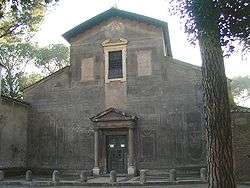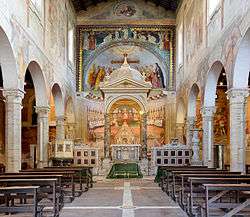Santi Nereo e Achilleo

Santi Nereo e Achilleo is a fourth-century basilica church in Rome, Italy, located in via delle Terme di Caracalla in the rione Celio facing the main entrance to the Baths of Caracalla. The current Cardinal Priest of the Titulus Ss. Nerei et Achillei is Theodore Edgar McCarrick.[1]
History
A 337 epitaph inscription[2] in the Basilica di San Paolo fuori le Mura celebrates the late Cinnamius Opas, lector of a church known as Titulus Fasciolae;[3] the name has traditionally been explained as the place where St. Peter lost the foot bandage (fasciola) that wrapped the wounds caused by his chains, on his way to escape the Mamertine Prison.[4] In the acts of the synod of Pope Symmachus, in 499, the Titulus Fasciolae is recorded as served by five priests. This same building is recorded as titulus Sanctorum Nerei et Achillei in 595; therefore the dedications to Saints Nereus and Achilleus, two soldiers and martyrs of the 4th century, must date to the sixth century.
In 814, Pope Leo III rebuilt the old titulus. In the 13th century the relics of the two martyrs were transferred from the Catacomb of Domitilla to the Sant'Adriano, whence they were transferred to this church by Cardinal Baronius.[5]
The church degradated with the time, and in 1320, according to the Catalogue of Turin, it was a presbyterial title with no priest serving. So Pope Sixtus IV restored the church in occasion of the Jubilee of 1475, while the Jubilee of 1600 was the occasion for the last major restoration, funded by the scholarly antiquarian Cardinal Cesare Baronio, who commissioned the frescoes.
Interior

Behind its unassuming facade the church is built according to the typical basilica plan, with a single nave and two side aisles. The original columns were replaced in the 15th century by octagonal pillars, and the nave is characterized by the large fresco decorations commissioned by Cardinal Baronio.
The cardinal in his iconographic scheme timed for the 1600 Jubilee emphasized the role of the Roman martyrs during the early centuries of Christianity. The execution of the frescoes were entrusted to a minor painter, generally thought to be Niccolò Circignani, called "Pomarancio".[6] There are a lot of gruesome details and blood all over the walls, but the pastel colours soften somewhat a fearsome effect of the pictures.
The medieval ambo is set on a large, porphyry urn taken from the nearby Baths of Caracalla. The low screen separating the choir is faced with 13th-century Cosmatesque style inlays. A white marble candelabra has been brought here from San Paolo fuori le Mura.[7] The ciborium, dating to the 16th century, is raised on African marble columns.
The spandrels of the arch at the end of the nave retains some of the former mosaics of the time of Leo III, with a central Transfiguration in a mandorla. The high altar, made of three Cosmatesque panels, houses the relics of Nereus, Achilleus, and of St Flavia Domitilla; all three of them where brought here from the Catacomb of Domitilla. Next to the altar there are two pagan stones depicting two winged spirits, taken from a nearby temple.
In the apse behind the altar is the episcopal throne assembled under the direction of the antiquary Cardinal Baronius, reusing lions, in the Cosmatesque style that is associated with the Vassalletto school, which support the armrests; on the backrest is inscribed the opening and closing words of the twenty-eighth homily of St. Gregory the Great, inscribed under the mistaken tradition that he preached them here, in front of the relics of Sts. Nereus and Achilleus on their feast day. When Cardinal Baronio ordered the inscription,[8] he did not know that the relics were originally buried in the underground basilica of the Catacomb of Domitilla, so thought that this was the place St Gregory preached.[9]
The arch of the apse has mosaics of the 9th century with the Annunciation, the Transfiguration, and the Theotokos (Madonna and child).
Coordinates: 41°52′48.8″N 12°29′41.2″E / 41.880222°N 12.494778°E
See also
- Pierfrancesco Scarampi (buried there)
References
| Wikimedia Commons has media related to Santi Nereo e Achilleo (Rome). |
- ↑ . The cemetery church of the catacomb of Saint Domatilla on the Appian Way, virtually lost in the early Middle Ages and rediscovered in the 1870s by the archaeologist Giovanni Battista de Rossi, carries the same dedication to Nereo and Achilleo; it is discussed by Joan M. Petersen, "The identification of the Titulus Fasciolae and its connection with Pope Gregory the Great", Vigiliae Christianae 30.2 (June 1976:151–158).
- ↑ Date 337 noted in Touring Club Italiano, Roma e dintorni, 1965:385.
- ↑ Another epitaph inscription exists, of 377, to Felix, probably the Felix, presbyter Tituli Fascioli, who was father of Pope Felix III and was mentioned in Liber Pontificalis (Petersen 1976:155)
- ↑ The traditional episode was recounted in the sixth-century Acta SS Processi et Martiniani (Petersen 1976:153, notinmg Acta Sanctorum, July, vol 1:304f).
- ↑ Petersen 1976:152.
- ↑ TCI 1965 gives the attribution to Pomarancio.
- ↑ TCI 1965:385.
- ↑ The inscription is connected with him in V. Lais, Memorie del Titolo di Fasciola, Rome, 1880, noted by Petersen 1976:151 note 1.
- ↑ Petersen 1976.
- Roma, collection "L'Italia", Touring Editore, 2004, Milano.